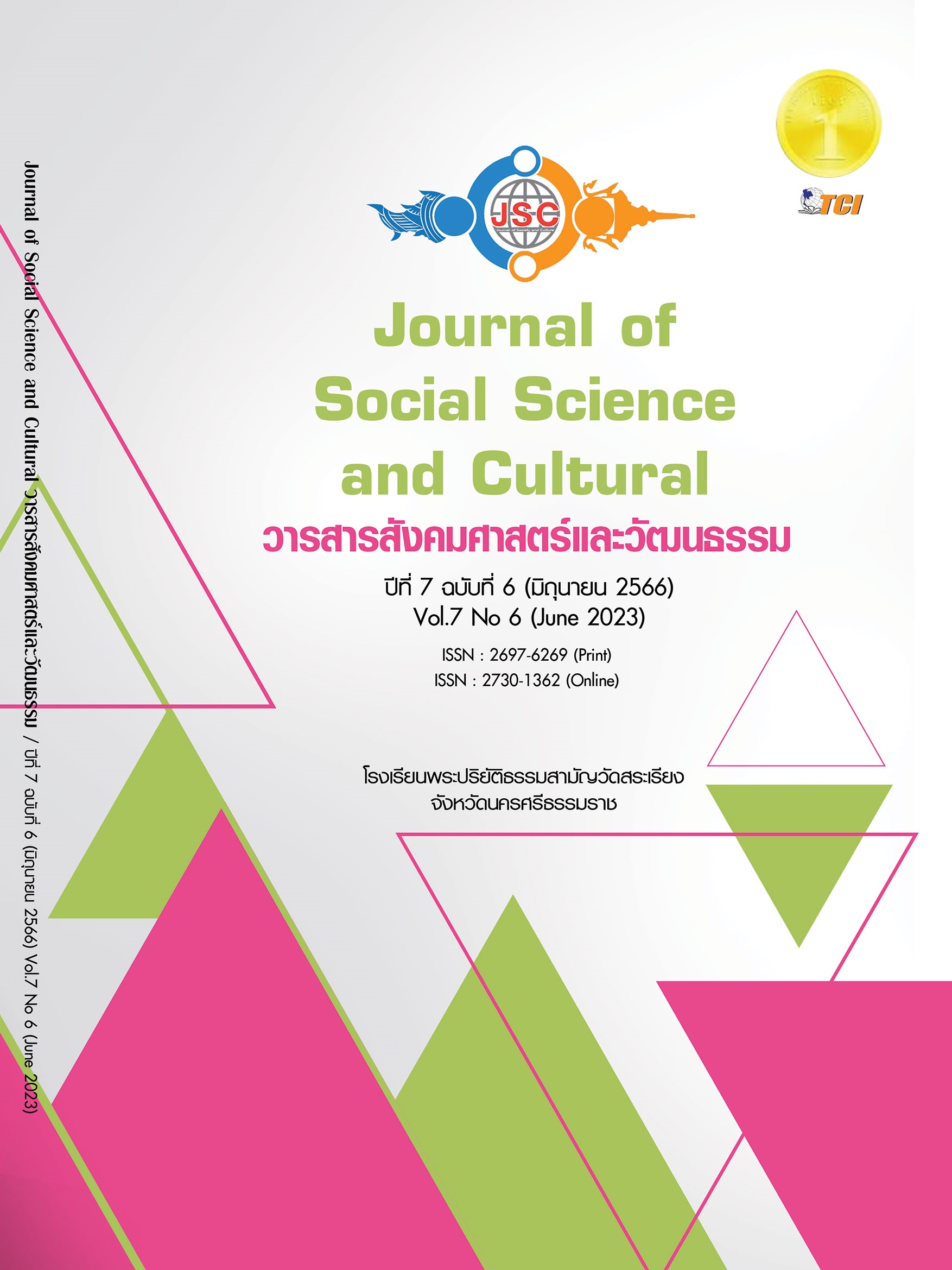THE CAUSAL RELATIONSHIP MODEL OF GOOD CORPORATE GOVERNANCE PRINCIPLES ON COMPETITIVENESS OF COMPANIES LISTED IN THE STOCK EXCHANGE OF THAILAND
Main Article Content
Abstract
This paper aims to study relationships and examine the consistency of the linear structure of good governance practices that affect the competitiveness of listed companies on the Stock Exchange of Thailand. The researchers used listed companies in the Stock Exchange of Thailand (SET). The total number of companies in the financial sector is 629 companies, with a random population of 7 industrial groups companies listed on the Stock Exchange of Thailand (SET) as the research population in all industries except financial groups. 293 companies received responses from the questionnaire as data collection tools. They used descriptive statistics to analyze data such as frequency, percentage, and hypothesis by structural equation analysis. (MODEL--SEM) LISREL PROGRAM. The research found that the correlation path of the empirical data-relational model test found that objective determination (OBJ) with objective function (IMPE) with a statistically significant path coefficient of 0.67 at 0.05 and defined objective performance (IMPE) with performance monitoring and disclosure (EVL) had a statistically significant path coefficient of 0.91, at 0.05 defined objective performance (IMPE) with competitive capability. (COMPET) has a statistically significant path coefficient of 0.61 at 0.01. Performance and disclosure assessment (EVL) with competency (COMPET) has a path coefficient of 0.14 statistically insignificant and the correlation model is consistent with empirical data. The research hypothesis is consistent with empirical data. There is a correlation path based on the hypothesis of the correlation index. With Chi-Square (χ2) = 58.48 (p-value = 0.017) statistically significant, χ2/df = 1.54, GFI = 0.96, CFI = 0.99, AGFI = 0.94 and RMSEA = 0.043.
Article Details
References
เพ็ญจันทร์ แสงอาวุธ และคณะ. (2563). การกำกับดูแลกิจการผลการดำเนินงานและมูลค่ากิจการตามราคาตลาดของบริษัทจดทะเบียนในตลาดหลักทรัพย์แห่งประเทศไทยในกลุ่ม MAI. วารสารสุทธิปริทัศน์, 34(109), 1-16.
เศรษฐพุฒิ สุทธิวาทนฤพุฒิ และคณะ. (2556). จับชีพจรประเทศไทย A Nation in Decline. กรุงเทพมหานคร: ภาพพิมพ์.
กุลยา จันทะเดช. (2561). หลักการกำกับดูแลกิจการที่ดีสำหรับบริษัทจดทะเบียน ปี พ.ศ. 2560. วารสารวิชาชีพบัญชี, 14(41), 73-93.
ฆณาการ ปุปะระ และคณะ. (2558). ปัจจัยการกำกับดูแลกิจการของบริษัทที่ส่งผลต่อผลการดำเนินงาน: กรณีศึกษากลุ่มอุตสาหกรรมธุรกิจการเงินที่จดทะเบียนในตลาดหลักทรัพย์แห่งประเทศไทย. Journal of Business Administration The Association of Private Higher Education Institutions of Thailand, 5(1), 34-42.
ฐิติพร พระโพธิ์. (2563). การกำกับดูแลกิจการที่ดีมีอิทธิพลต่อการจัดการกำไรและมูลค่ากิจการของบริษัทจดทะเบียนในตลาดหลักทรัพย์แห่งประเทศไทย. In Ringgit Graduate Research Conference: RGRC, 15(2563), 1732-1741.
ตลาดหลักทรัพย์แห่งประเทศไทย. (2560). หลักการและแนวทางปฏิบัติด้านการกำกับดูแลกิจการที่ดี. เรียกใช้เมื่อ 29 มีนาคม 2564 จาก http: //www. Set. or.th/ sustainable dev/th/cg/principle p1.html printable true
ตลาดหลักทรัพย์แห่งประเทศไทย. (2561). การจ่ายปันผล. เรียกใช้เมื่อ 20 ตุลาคม 2561 จาก https://www.set.or.th/th/ regulations/simplified regulations/ files/20181129 Dividend.pdf
ตลาดหลักทรัพย์แห่งประเทศไทย. (2563). แผนยุทธศาสตร์ ก.ล.ต. ปี2563-2565. เรียกใช้เมื่อ 16 ธันวาคม 2563 จาก https://www.sec.or.th/ TH/Documents/strategic plan/strategicplan-2563-2565.pdf
ตลาดหลักทรัพย์แห่งประเทศไทย. (2565). หลักการกำกับดูแลกิจการที่ดีสำหรับบริษัทจดทะเบียน 2565. เรียกใช้เมื่อ 29 มีนาคม 2564 จาก https://www.sec.or.th.
ธีรนันท์ ศรีหงส์. (2563). อันดับความสามารถในการแข่งขันของไทย. กรุงเทพมหานคร: สำนักงานคณะกรรม การพัฒนาระบบราชการ.
ปิยะณัฐ ถุนพุทธดม และคณะ. (2561). ศึกษาปัจจัยที่ส่งผลต่อแรงจูงใจในการจัดการกำไรในตลาดหลักทรัพย์แห่งประเทศไทย. วารสารมนุษยศาสตร์และสังคมศาสตร์มหาวิทยาลัยธนบุรี, 13(3), 145-157.
สมาคมซีเอฟเอไทยแลนด์. (2549). “การกำกับดูแลกิจการของบริษัทจดทะเบียน: คูมือสำหรับนักลงทุน.” (ระบบออนไลน). เรียกใช้เมื่อ 28 มกราคม 2551 จาก http://www.set.or.th/th/regulations/ cg/files/2006/ CFA CG Manual for Investors THAI. pdf
สุภานี นวกุล. (2553). การกำกับดูแลกิจการกับความสามารถในการแข่งขันของบริษัทจดทะเบียนในตลาดหลักทรัพย์แห่งประเทศไทย. กรุงเทพมหานคร: สถาบันบัณฑิตพัฒนบริหารศาสตร์.
สุภาวดี ขุนทองจันทร์. (2551). “ความสัมพันธ์ระหว่างคุณลักษณะบรรษัทภิบาลกับศักยภาพในการแข่งขันของผู้ประกอบการวิสาหกิจขนาดกลางและขนาดย่อมในเขตภาคตะวันออกเฉียงเหนือ”. วารสารวิชาการมหาวิทยาลัยอุบลราชธานี, 10(2), 117-132.
Arbuckle, J. J. (1995). AMOS User’s guide. Chicago: Small Waters Corporation.
Bulathsinhalage, S. & Pathirawasam, C. H. (2017). The Effect of Corporate Governance on Firms’ Capital Structure of Listed Companies in Sri Lanka. Journal of Competitiveness, 9(2), 19-33.
Diamantopoulos, A. & Siguaw, A. D. (2000). Introducing LISREL: A guide for the Uninitiated Sage. Publications, London: Kaplan.
Gill, A. & Shah, C. (2012). Determinants of corporate cash holdings: Evidence from Canada. International Journal of Economics and Finance, 4(1), 70-79.
Kiyosaki, R. T. & Lechter, S. L. (2010). Fu ba ba xiong ba ba [Rich dad, poor dad] (L.Qinggi, & S. L. Zhu, Trans.). Hai Kou: Nan Hai Chu Ban She.
Kline, R. B. . (2011). Principles and practice of structural equation modeling. (3rd ed.). New York, N: The Guilford Press.
Obaid, M. M. & Amrah, M. R. (2020). Emerging policies and the effectiveness of corporate governance mechanisms on earning quality: A conceptual framework for Gulf cooperation council. International Journal of Research in Business and Social Science, 9(3), 157-164.
Porter, M. E. (2008). On Competition. Updated and Expanded Edition. Boston, MA: The Harvard Business School Press Review Book.
World Economic Forum. IMD2006. (2006). “Europe: What to watch out for in 2016 – 2017”. 11th ed. Geneva: World Economic Forum.


